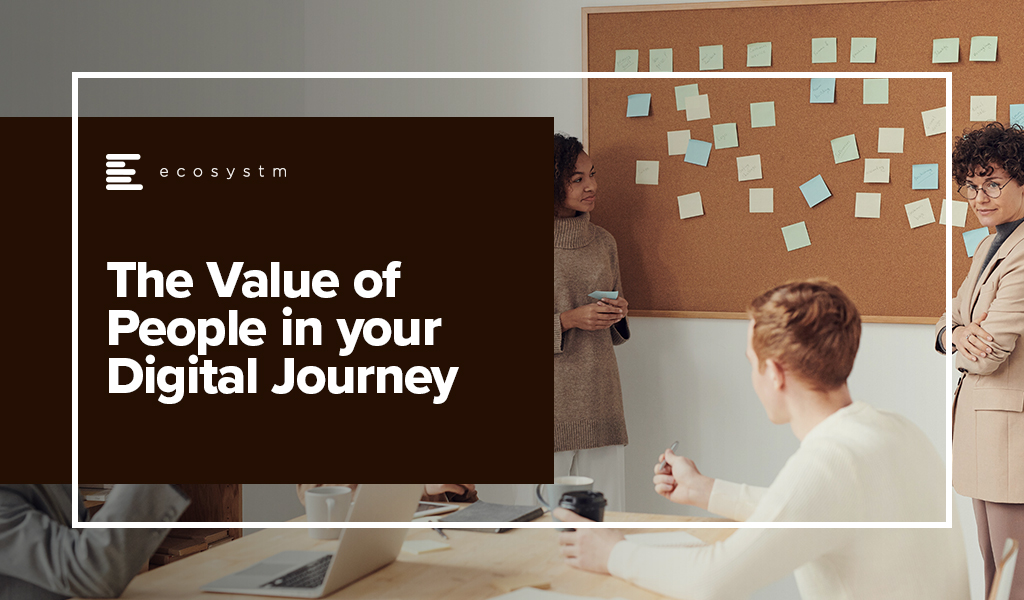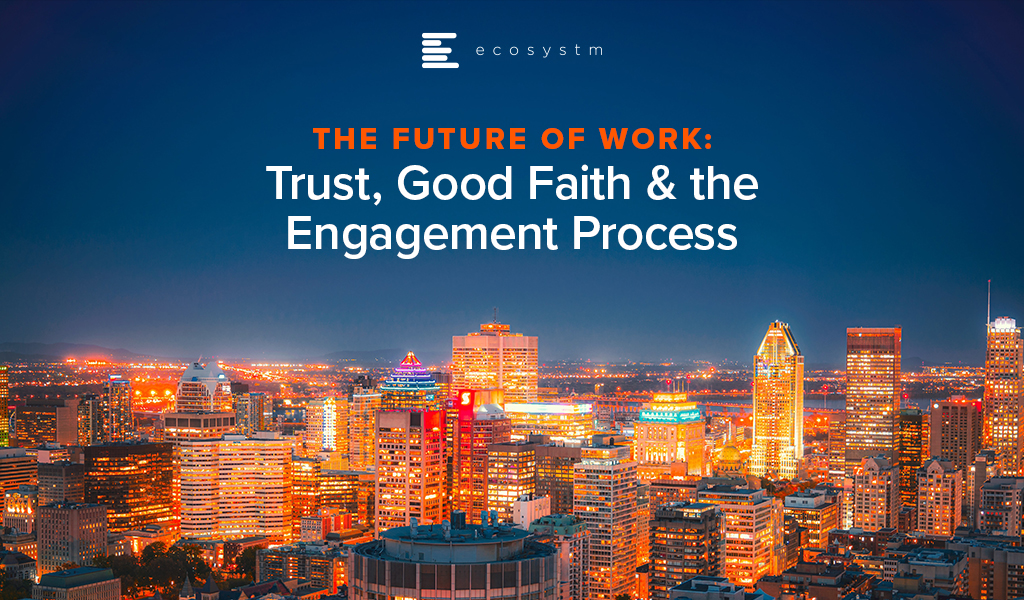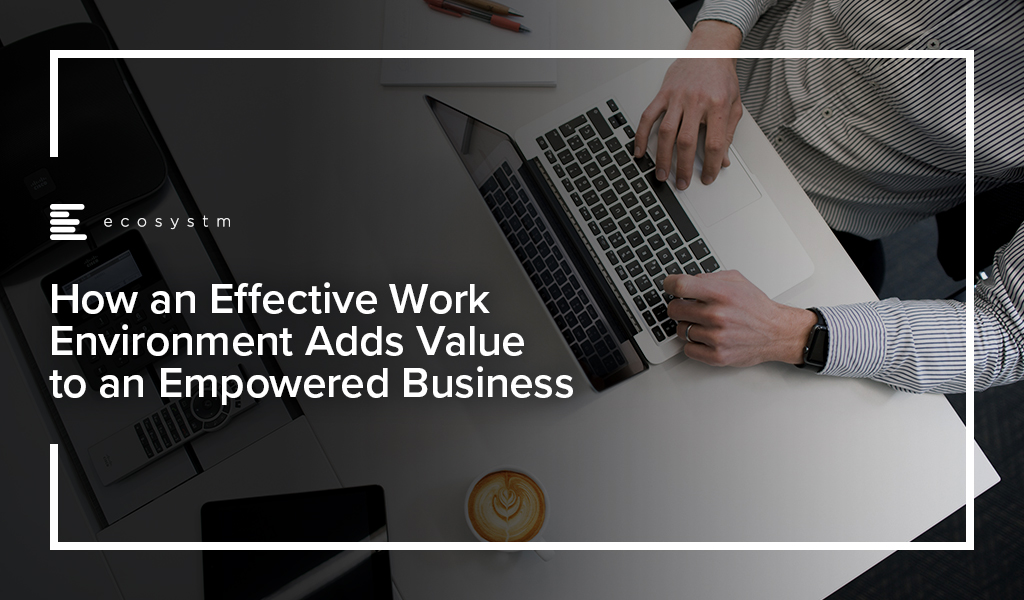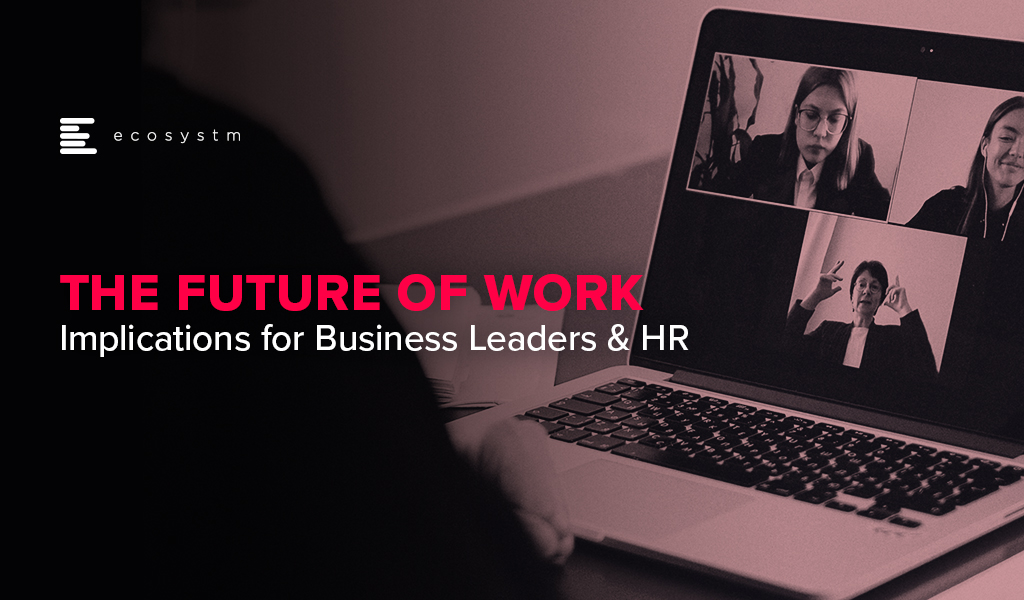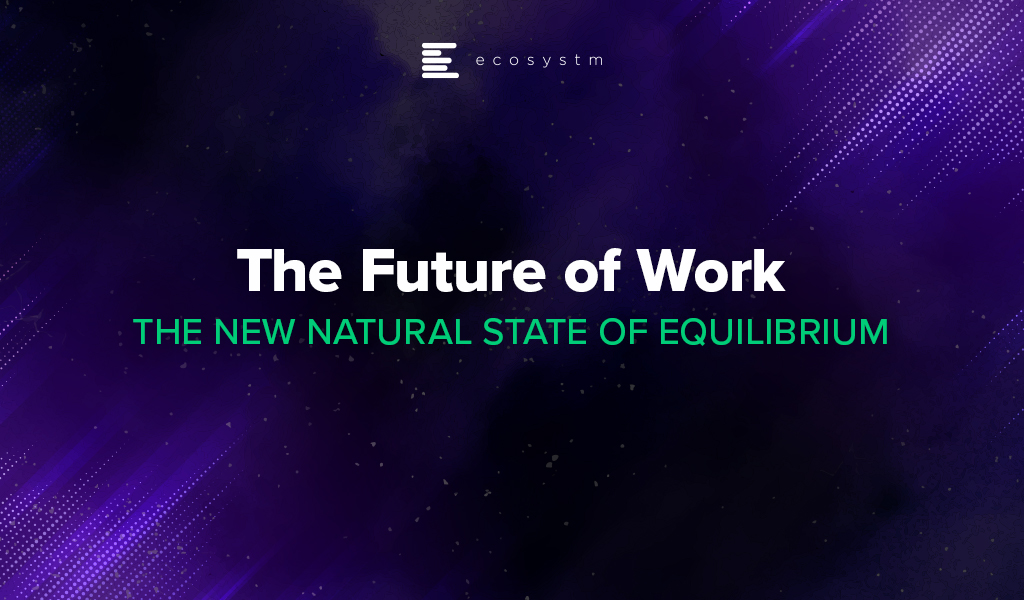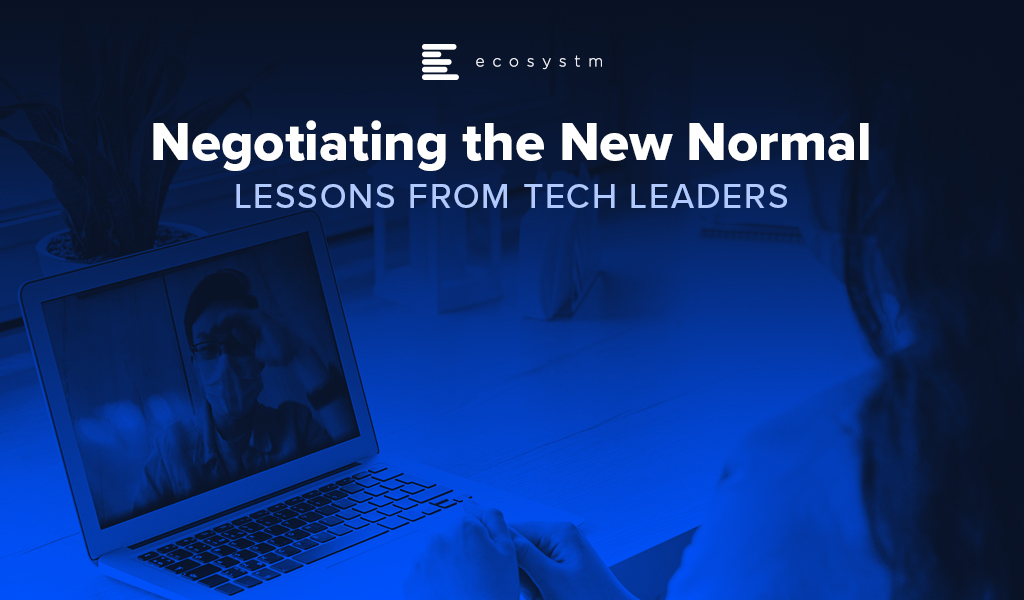Fundamentally, any change has to be about people. And the Digital Value Journey that we are introducing in the upcoming CXO Digital Leaders Dialogue Series is no different.
The journey covers five stages of development involving five capabilities. Still, without the engagement of the people who will be affected by the change, you will not make progress.
And the situation gets even more complicated when external events impact your business. Ecosystm research unearths the impact of COVID-19: over 90% of respondents changed their planned Digital Transformation in some way (Figure 1). These changes will inevitably mean that the anticipated behaviour changes from their teams no longer apply. Getting the affected people re-engaged with the new initiatives will not be a simple task.
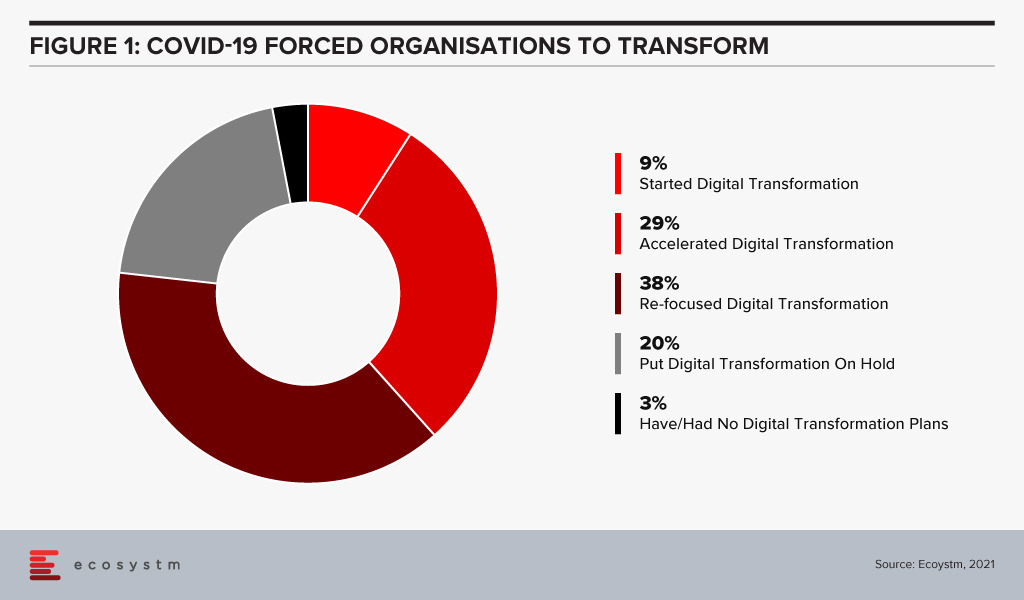
For example, when an organisation I worked at integrated an information-as-a-service capability, we found that our most experienced people did not use the new capability! They preferred to stick with their paper sources as they were very good at finding what they needed.
So nothing is achieved unless someone acts differently. We can change the technology, and we can change the process, but unless the people who need to change do change, we will waste everything else we do.
The scale of the change really doesn’t matter. If people are not in a mindset where they are looking to improve, we waste our time.
In the example I mentioned earlier, our store teams used catalogues to look up parts and equipment for customers. Our most experienced people were amazing – they knew which of the myriad of catalogues was going to give them the best part. We had not convinced them that the real-time system, which the supplier updated constantly, was better for them than the last paper version they had received.
So, on the Digital Value Journey, travellers need to remain very aware of the state of mind of the people whose behaviour they expect to change. Getting and keeping these people engaged is essential to the change.
People’s Resistance to Change
But why do people resist (or just plain ignore) change? How clear are you on what is in it for them?
Recent research on people’s motivation by psychologists such as Daniel Kahneman highlights that people fear loss much more than they look forward to success. To overcome this loss aversion, we need to help people understand why their lives will be better once we’ve completed the change and specifically address their concerns.
When we were looking at replacing the paper catalogues, we told the store teams that they would be able to quickly and easily search across all the catalogues available to them to give the customer the best deal. We didn’t consider that the ability to find the right part was a source of pride for some of the team. It was a skill that our experienced team members had developed over the years, and they felt we were devaluing their expertise.
We need to help those affected by the change recognise the purpose of the change and what is in it for them. If there is nothing, then why change?
And leaving people behind on the change journey is never going to lead to success. Their clear understanding of the purpose of the change is essential to getting the anticipated benefits.
I’ve seen change activities launch with a hiss and a roar, but as the pressure comes on during the delivery stages, communication and collaboration drop away. Listening carefully and responding authentically is a necessary part of the journey right through implementation until our teams have fully adopted the changes. A change doesn’t end at the implementation of a capability.
And that catalogue replacement? The delivery team kept listening to the store teams and made some great changes that were asked for. Some of the changes we didn’t understand, but the store teams were adamant. And the development paid for itself in less than six months through increased and better quality sales.
How do digital leaders shift from providing a cost-focused to a value-focused service? At the CXO Digital Leaders Dialogue series, together with Best Case Scenario, we will be in discussion with leaders who will share their experiences on navigating their digital journey.
To learn more, or to register to attend, visit here

Many opinions exist on how automation and machine learning will help our return to the office environment. Removing physical touchpoints and leveraging machine learning to trace employee behaviour can help with the transition back to the workplace. But will people trust the office’s automated suggestions on where to work in the building, or help themselves to alternative workspaces?
Processes & Trust for People Engagement
Organisations such as Disney and Amazon understand what kinds of processes and trust it takes to engage people. These organisations took their time to create a vision of the contactless trusted experience before developing an implementation plan. The RFID wristbands at Disney that open hotel doors and get you on to rides involve many elements of trust and privacy. The automated order and delivery tracking of Amazon, along with suggestions and buying patterns, require the person to opt-in and share information to make happen.
So for your company, once employees re-enter the workplace, how will your company create those processes, that level of trust and faith, that would allow movements and health status to be tracked by office automation? For example, how often should employees overtly be aware of their temperature being scanned?
Abilities of Buildings to Manage
Facilities management is trending towards intelligent building management systems (iBMS) which know about room occupancy, room hygiene and are tracking who has been where and with whom. Elevators will limit occupancy and direct users to the correct lift going to the correct location. I have already seen this in our city hospital where you get directed to the correct lift once you have entered information on your destination. This combines user interface devices such as touchless pads, system hardware, and access control management software.
The building can also possibly direct you via a building app to request a place to work. You could swipe your personnel card and then be shown several options based on your personal profile and job role, including private quiet rooms, communal areas, and outside meeting tables. Previous occupants can be noted to share hygiene tracing if necessary. Intelligent buildings already offer direct support to the employees who interact with them for HVAC, lighting control, and occupation sensor. They have the ability to reduce user friction while raising workplace experience metrics to create a measured environment.
User Trust & Participation
Users should be willing to participate to get access. To create the trust that is required for employees to be willing to participate in the process, companies need to share policies and demonstrate stewardship of the data accessed. Who is holding my locational data, for how long, and for what purpose?
Trust facilitates successful data sharing, which in turn reinforces trust. Trust is built when the purpose of data sharing is made clear, and when those involved in the process know each other, understand each other’s expectations, and carry out their commitments as agreed. Trust increases the likelihood of further collaboration and improves core surveillance capacity by supporting surveillance networks.
Conclusion
Will we put our trust in buildings and facilities management on our return to the office? If communication is clear and policy well articulated, the building can play a role in engaging users to return to some standards of in-office participation. But if communication is muddy and policy not made clear, people will make their own way to safety – potentially impacting the environment of others.
Transform and be better prepared for future disruption, and the ever-changing competitive environment and customer, employee or partner demands in 2021. Download Ecosystm Predicts: The top 5 Future of Work Trends For 2021.

The 360o Future of Work practice takes into account the changing business environment, and what companies need to become an “Empowered Business”. It consists of four components: The Business, The People, The Technology, and The Work Environment.
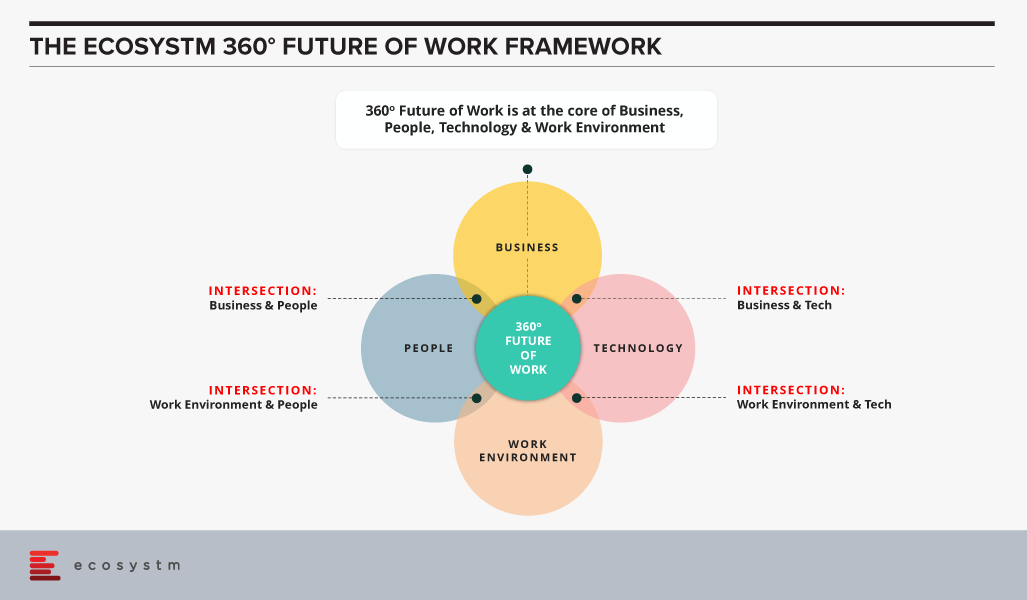
Here we focus on the Work Environment, and its intersection with the three other components.
Work Environment: A Component of the 360o Future of Work
Companies and people have learned work can be performed in many types of environments, just as business is conducted in varying venues. Each space will have a different impact and outcome. The three primary commercial areas are: office, industrial and retail. While industrial and retail commercial areas will be addressed later, we talk here primarily of the office environment. The office environment is designed to enable both collaborative and individual work. It has historically been densely packed. Post COVID-19, this environment will probably be modified. For the past few years, an alternative to the office environment has been co-working – a shared work environment with other companies, in open plan arrangements. It provides a way for business to save capital by minimising the expense of fit out. The combination of using both office and co-working environment is what will begin to be called “the Blended Environment”.
The Work Environment and its Intersections
While the Work Environment is an important component of the Future of Work, it is a co-enabler with Technology to support the People and Business.
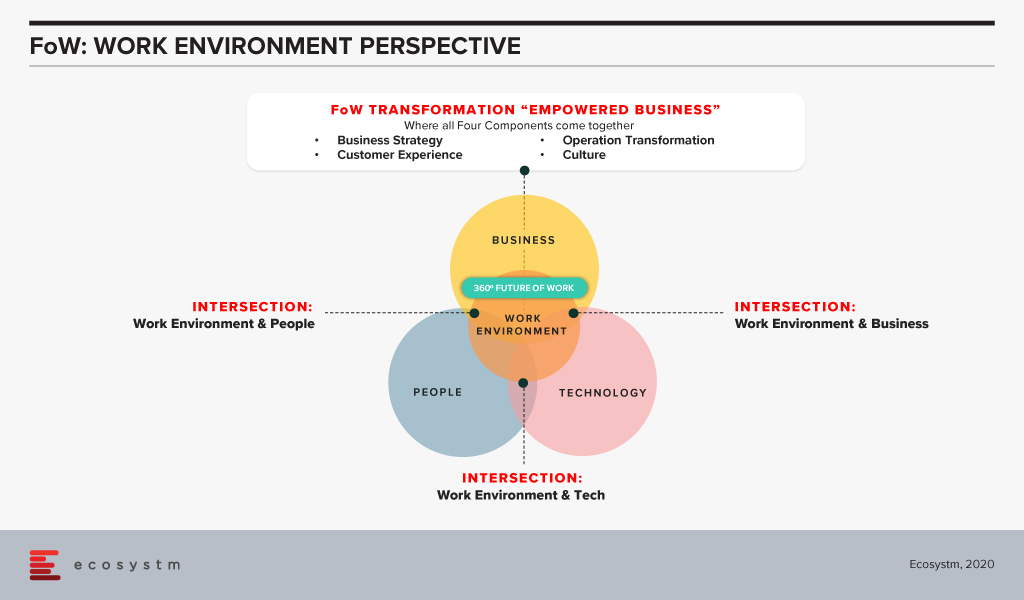
Work Environment – Intersection with the Business
The Business’s role is to provide Strategy and Direction. If done effectively it can take on unknown challenges. Examples of how the Business intersects with the Work Environment would be:
- Providing agility to the Business in preparing for any future crises. Some examples of how this can be done is by looking at how the space is controlled by the lease conditions, and how it is used by the occupants and the type.
- Aiding to minimise risk from excess space. An example would be space options for a lease. This will enable both spatial and financial flexibility for the company to expand or contract as needed.
Work Environment – Intersection with People
A critical component of the Empowered Business is its People – its workforce. For any company, the People are the key asset. They have to be able to grow and develop, in order to provide collaboration and idea creation. Examples of how the Work Environment can empower the People would be:
- The focus is on aligning the space with the employee’s task.
- The focus is on aligning where a person needs space to be effective, and the task the person needs to perform.
Work Environment – Intersection with Digital (Technology)
One of the important enablers of any Business, especially the Empowered Business, is its Digital Tools. They support the Business and its People, along with the Work Environment. They allow the Work Environment to be productive and effective. Examples of how Technology and the Work Environment intersect would be:
- This is where the two enablers (Digital Tools and Work Environment) work together to aid the employees and the business.
- This relates to how to manage the Business’s portfolio of space from a remote location.
These four components working together will enable an Empowered Business. The Work Environment as an enabler allows the Business to pivot, adapt, and thrive in the most challenging environment. It allows the Empowered Business to be better prepared to meet future crises head-on.
Schedule a time to speak with us on Future of Work
Ecosystm Principal Advisors; Tim Sheedy & Audrey William (Technology), Ravi Bhogaraju (People & Organisations), and Mike Zamora (Work Environment) provide a holistic view of what the Future of Work will look like.
We enable businesses to adapt, pivot and thrive in their ecosystem; provide holistic access to data and insight across People, Technology and Work Environment; help businesses transform and be better prepared for future disruption, and the ever-changing competitive environment and customer, employee or partner demands.
Contact us through the platform, or over email at info@ecosystm360.com

The COVID-19 crisis has required major resets in how organisations function – across industries and economies. In this environment of intense changes, businesses that have been agile in their operations and were better digitally enabled have thrived, while others have struggled. Irrespective of whether an organisation has been able to pivot fast to thrive or struggled to cope, it is very clear that the Future of Work is here now. Every organisation has had to make some changes to their People and work practices. It is time to (re) focus on employee experience holistically so that organisations can be ready for whatever model of work becomes prevalent in the future. I have recently published a report offering guidance to business leaders and HR Teams on how to make holistic workplace shifts, with inputs from Ecosystm Principal Advisors, Tim Sheedy and Audrey William.
Employee Experience at the Core of Customer Strategies
It has become increasingly clear that customer experience (CX) is not just about good sales skills or customer service. It is about the overall experience of the customer from start to post-purchase. Customers are focused on not just what they are buying but also on how they are treated along their entire journey. Good CX has consistently shown to help increase price premium, impulse buying, and loyalty. Consequently, one bad experience can drive a customer away forever. Customers pay for your products or services, but it is your people who can really deliver the experience.
Audrey says, “As it becomes clear that we are headed for a hybrid/blended model of work, employee experience (EX) has to be a key focus area for organisations. Organisations will have to support remote work and simultaneously evolve their physical workplaces so that employees have the choice to come into work. But business leaders and HR will definitely have to come together to re-evaluate their policies around employees and improving EX – irrespective of where they choose to work from.”
The Role of Productivity in the Digital Workplace
Productivity has been at the core of an organisation’s desire to be a digital workplace. Tim says, “A digital workplace is one that has the capability to support any employee to access the process, information or system they need on their device of choice, in their moment and location of need. In the wake of the pandemic, the digital workplace went from being a ‘good idea’ to an ‘absolute necessity’ – and the seeds were sown to build true digital workplaces, years ahead of plan.”
This is the time to retain that focus on productivity. A lot of energy is being spent in defining and measuring productivity. The focus seems to have shifted to how to get the best out of the remote/hybrid workforce. It is time for business leaders and HR to go back to the drawing board to re-define what productivity means to their organisations.
Tim says, “The focus should be on enabling productivity rather than on monitoring activity. Productivity is an outcome, not a process. So, measure the outcome, improve the process. Productivity will be driven at an organisational level through removing friction from overall operational processes, to make things more streamlined and effective to create more value.”
The True Implication of Flexibility
There has been a rapid shift in practices around working from home and flexibility. But it is time now for organisations to create a framework (policy, performance expectation and management) to manage these practices. Many companies do not really understand the implications of flexible working to their business. In fact, they may be unaware of shifts in work patterns that have taken place in the last few months and the impact these shifts are having on the business.
Framework around flexible working should be backed by data and an understanding of the feasibility of such practices. If your employee has to work on her compulsory day off, then you do not have a truly flexible work practice. This will have a negative impact on employee experience and ultimately on your business.
The Evolution of Employee Engagement
Audrey says, “One of the areas that business leaders and HR will have to bear in mind is that despite flexible working hours, employees might be overworked – it is emerging as a common problem with working from home. It is common that many employees are working longer hours.”
Ecosystm research finds that some organisations have been evolving their HR practices, since the start of this crisis (Figure 1).
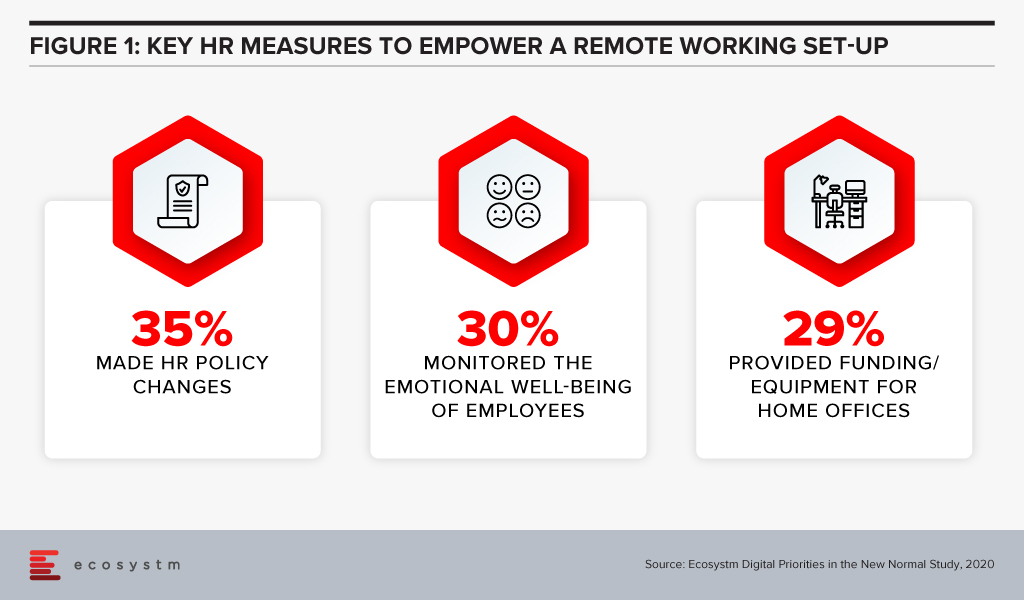
But more needs to be done. Organisations have to work really hard to replicate their employee engagement and social hours in the virtual world. It is critical that organisations design mechanisms of keeping employees connected – to each other, as well as to the organisation. “Virtual social groups” not only provide this connection, it can also be a rich source of input for HR and wellness teams to quickly adapt their programs to meet the changing needs of employees.
Shift in Managerial Styles
Performance management has been traditionally done through annual cycles, and by monitoring and tracking. In the Future of Work, organisations will have to increasingly give their employees the choice of working from home. Meetings, check-ins, 1:1 and team huddles for close monitoring will not work in this remote/hybrid model.
It is time to stop close monitoring and really focus on outcome-based management. And this will have to start with re-skilling people managers. Training should be provided on softer skills such as emotional intelligence, being able to sense across boundaries and digital spaces, and being able to be responsive to employees’ needs. The people manager must evolve into being a coach and a mentor – internal coaching and mentoring networks will have to be established. Line managers, business leaders and HR teams will need to collaborate more to ensure that these skills are developed and that the right support system is in place.

As the saying goes, the “Future Ain’t What it Used to Be”. This has certainly been true of 2020. There have been many aspects of business that have rocked the foundation of what “used to be”, i.e. technology, changing business models, and digital transformation – all amid the onslaught of the coronavirus. All of these have affected every industry and every business, quite literally around the world.
Some businesses and individuals are beginning to effectively address and deal with this continuously evolving landscape. Others are unsure how to proceed. And still others are freezing like a deer in the headlights of an oncoming vehicle. While no one can predict the future with certainty, it is still possible to assess their rapidly changing environment and develop business scenarios to consider the various potential outcomes.
COVID-19 has impacted all businesses, industries, and individuals. It has impacted how both business and work is conducted. Even after the crisis has passed, new ways of doing both will be required. The businesses which are thriving right now understand these changing requirements and how they might impact their Future of Work. They have learned what is required for them to compete through a New Holistic approach in order to be agile and adapt to sudden changes and a very competitive global marketplace.
At Ecosystm, we have developed a new 360o Future of Work practice, based on the changing business environment and what companies need to adapt, pivot and thrive. The 360o Future of Work practice is comprised of four components:
- The Business (organisation)
- The People (employees)
- The Technology (tools)
- The Work Environment (where work is done)
The Business component is of course the driver. The People component is key – they are one of the most important assets to make the Business successful. They are the Talent. The Work Environment and Technology are critical enablers. As enablers they allow the People to be more collaborative, innovative, creative, and effective, to contribute to the Business’s success.
When all four components work in unison, the outcome is an effective Business designed to meet future challenges, competitors, and the unknown black swans – we call this organisation the “Empowered Business” (Figure 1). It is essential that each of these four components be understood and discussed and organisations seek advice in detail with respect to the specific business strategy in order for the Company to not only succeed, but thrive in the New Natural State of Equilibrium.
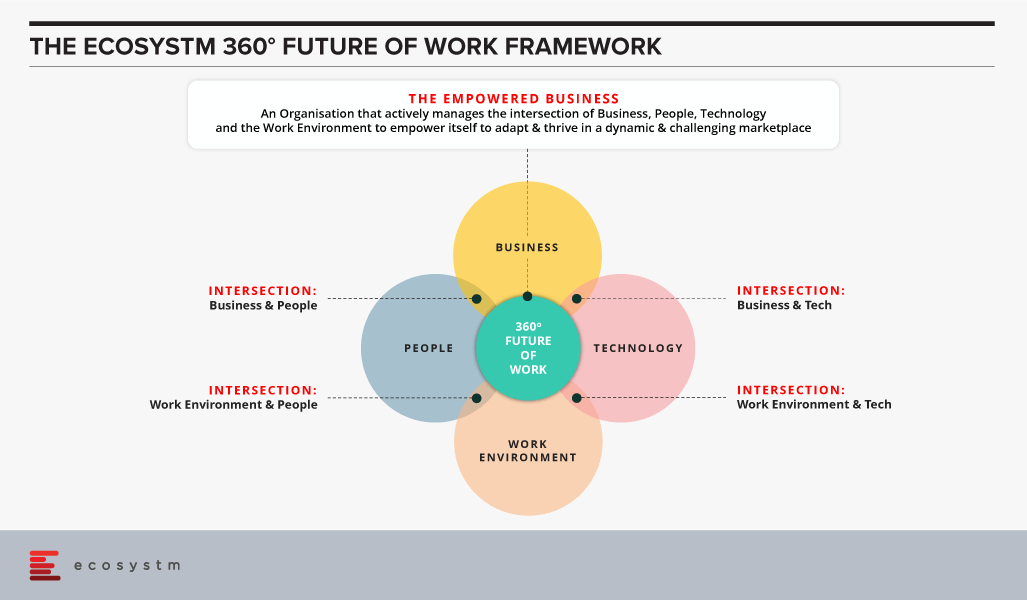
What to Expect
In subsequent articles, the 360o Future of Work practice leaders (Ravi Bhogaraju – People & Organisation; Tim Sheedy – Technology; and I – Work Environment) will discuss each of these components in detail and provide some insight as to how best to prepare for the new Natural State of Equilibrium, a post COVID-19 world.
For more information about the 360o Future of Work practice Or to speak to one of our experts, contact us on info@ecosystm360.com
As organisations come to terms with the “new normal”, technology companies are presenting unique offerings to help them tide over the situation and lead them towards economic and social recovery. These companies are also leading from the front and demonstrating how to transform with agility and pace – evolving their business and delivery models.
Organisations are dependent on digital technologies more than ever before. In 2020, we have already seen unprecedented and rapid adoption of technologies such as audio and video conferencing, collaboration tools to engage with employees and clients, contactless services, and AI/automation. This will have a wider impact on the technology industry, community, and redefining the workplace of the future.
Ecosystm Principal Advisor, Tim Sheedy hosted a virtual roundtable with business leaders from some of the world’s largest technology service providers to discuss how they managed the challenges during the pandemic; and the measures they implemented to support not only their business operations and working environment, but also to help their customers negotiate these difficult times.
The Role of Technology During the COVID-19 Crisis
When the COVID-19 crisis hit, IT teams found themselves largely unprepared. Ecosystm research finds that only 9% of organisations considered their IT fully prepared for the changes that had to be implemented (Figure 1). More than a third did not have the right technology solutions and 41% were unprepared for the scale of the changes required and the capacity to extend the existing technology to meet client and employee needs. 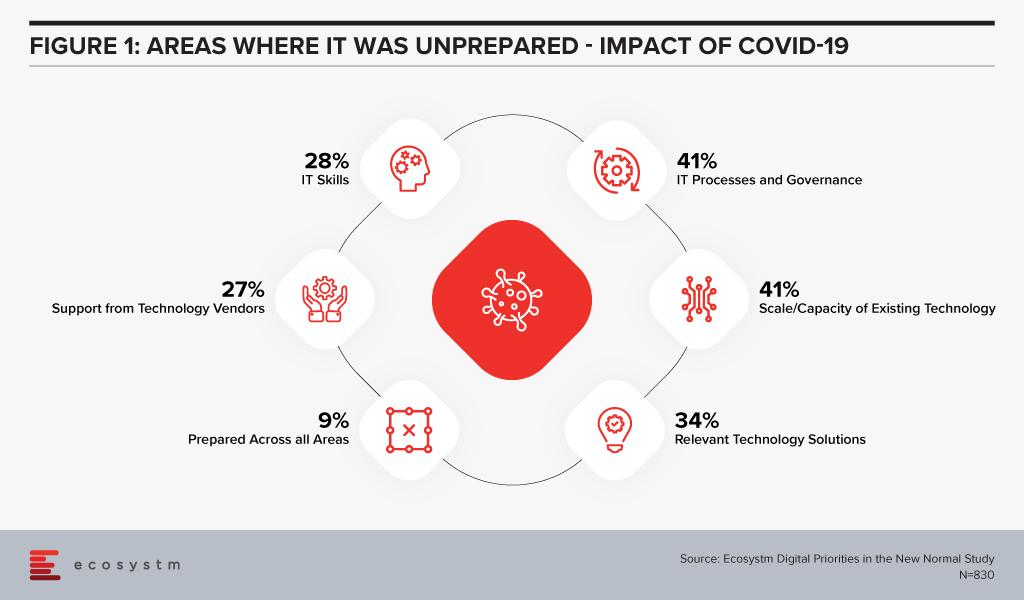
While 27% of organisations felt that they needed more support from their IT provider, further questioning reveals that only 4% switched technology providers for better support during these difficult times. Organisations are looking to their technology partners for guidance, as they negotiate the new normal.
Here are some of the discussion points that emerged in the conversation with the technology providers.
Business Continuity Planning is Still Evolving
One of the early impacts on businesses was due to their dependence on outsourced services and offshore models. Several concerns emerged – how could their provider continue to operate offsite; would they be able to access the network remotely; how should fully remote teams be managed and so on. In addition to this, there were other challenges such as supply chain disruptions and a sudden change in business. Even technology providers felt that they were navigating uncharted territory.
“Remote project delivery is not new, it’s been going on for a few years; but I think that there’s been a lot of non-believers out there. This experience has moved a lot of those non-believers to the believer category. A lot of our delivery can be done from home – think of the savings of time and money that can be realised through this.” – Andrew Campbell, Partner Asia Pacific for Talent and Transformation, IBM
Moreover, the rising workload and client expectation has led businesses to move towards exploring automation and AI.
“The thing that is changing now is, when we approach a new opportunity or an existing customer with a new requirement, we look at using automation. Typically, when you go in to design a solution you always think of the human aspect. We’re working very hard to move our thinking to automation first and then supplementing it with the human side as a backup.” – Michael Horton, Executive VP, ANZ, HCL Technologies
Data has become paramount in this time of crisis. The right use of data is helping organisations fulfil customer requirements, enhance their experience, and optimise services and products.
“Those organisations that have a good understanding of the data within their business, and how that data can be used to understand the impact on their business, are starting to have much better clarity on future requirements.” – Peter Lawther, Oceania Regional Technology Officer, Fujitsu
Organisations should take the learnings from managing this situation to keep evolving their business continuity plans – keeping in mind individual business needs and growth and business strategies.
Having the Right Infrastructure Means Employees are Productive
The lockdown and social distancing measures forced organisations to focus on the infrastructure that can support their remote and hybrid work environment.
“Before the pandemic around 20-30% of our staff logged on to a VPN, but with remote working, all of a sudden, we were at 90%.” – Lawther
The adoption of digital tools and online infrastructure led businesses to re-think how they were delivering their services. While some organisations had the tools, governance and the protocols in place, there is still a long way to go for organisations to solve their infrastructure and networking challenges.
“It gets down to the quality of the equipment that the staff use – which ranges from decent laptops, phones, and network connections. If you don’t have that now, people cannot work effectively.” – Horton
Several of these organisations, focused on ergonomics as well, when evaluating their employees’ infrastructural needs when working from home. This extra focus on infrastructural needs – with the employees firmly on their mind – ensured that there was minimal impact on delivery.
Caring for Your People is More Important than Ever
The pandemic has changed the way people work, socialise, and interact. While this appears to have become the new norm, adjusting to it can create emotional stress. Simultaneously, as organisations focus on survival and recovery, workloads have increased. Employees are working extended hours, without taking adequate hours. There is an immediate need to involve organisations’ HR practices in evaluating the emotional well-being of employees and finding better ways to engage with remote staff, to reduce stress.
“A key aspect of handling the crisis has been empathy, transparency and engagement with employees. In a business environment, we have all sorts of teams, cultures, clients, and so on. The common thread in this model is that everyone’s just become a lot friendlier, more empathic, more transparent.” – Sumit Nurpuri, COO, SE Asia Hong Kong and Taiwan, Capgemini
Organisations will have to be innovative in the way they manage these people challenges. For example, a common problem that has emerged is employees attending meetings, with interruptions from family, especially children.
“One of the things that we did as a part of our team meetings is that we assigned tasks to children at the beginning of the call and in the last few minutes, the children presented back to the teams on what they’ve been up to. It was a mechanism for us to make sure that we were involving our staff and understanding their current situation – and trying to make it as easy for them to work, as possible.” – Lawther
Taking the Opportunity to Drive Positive Outcomes
The other aspect businesses are trying to overcome is meeting the rising expectations of clients. This has led them to focus on skills training, mostly delivered through e-learning platforms. Organisations find that this has translated into increased employee performance and a future-ready workforce.
The crisis disrupted economies and societies across the globe, with business and industry coming to a standstill in most countries. Unexpected business benefits emerged from the necessity to comply with country regulations. By and large, employees have been more productive. Also, many organisations re-evaluated their commercial property requirements and many were able to reduce expenses on office rentals (for many this will not be immediate, but there is a future potentiality). Similarly, there were other areas where businesses saw reduced expenses – operational costs such as equipment maintenance and travel expenses.
“When you start global projects and global implementations, you typically do some kind of global design work and maybe fly in people from all over the world, typically to a centralised location. This has changed to virtual meetings and collaborative interactions on online global design. The amount of time and money that was saved – that would typically be spent on people traveling to manage these global design workshops – was great” – Campbell
Most organisations, across industries, will have to make considerable changes to their IT environment. The Ecosystm Digital Priorities in the New Normal study finds that 70% expect considerable to significant changes to their IT environment, going forward. Technology providers will remain a significant partner in organisations’ journey to transformation, recovery and success.



